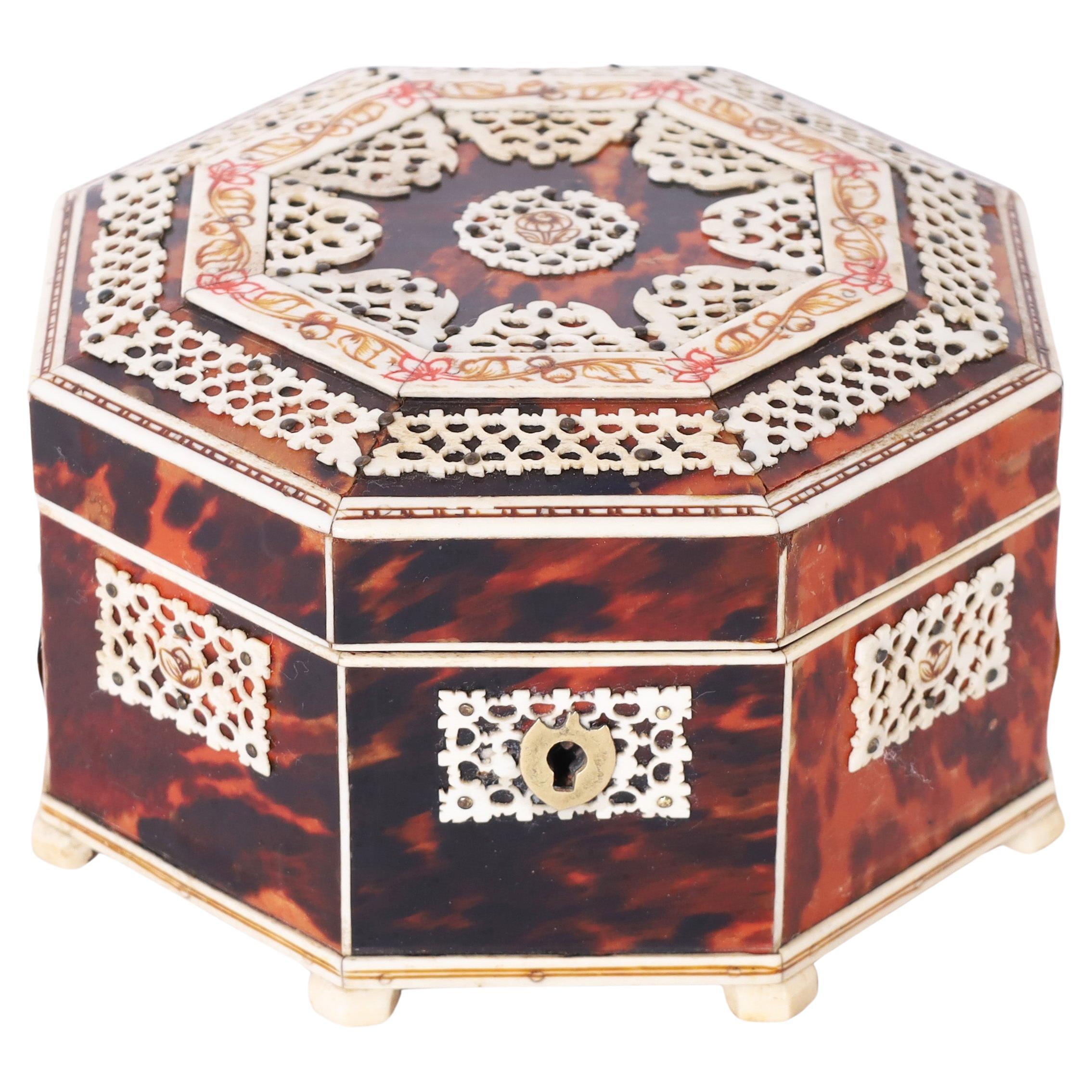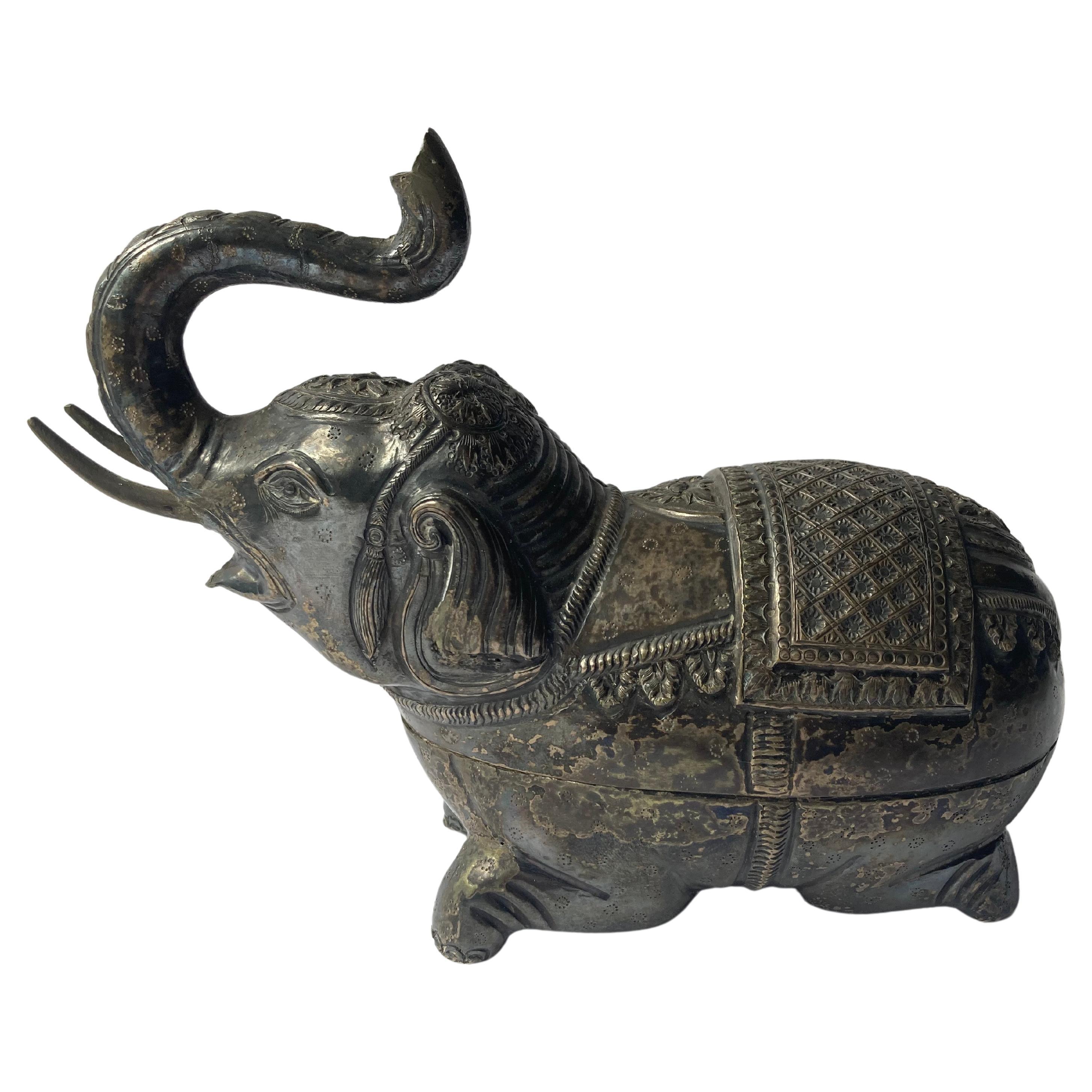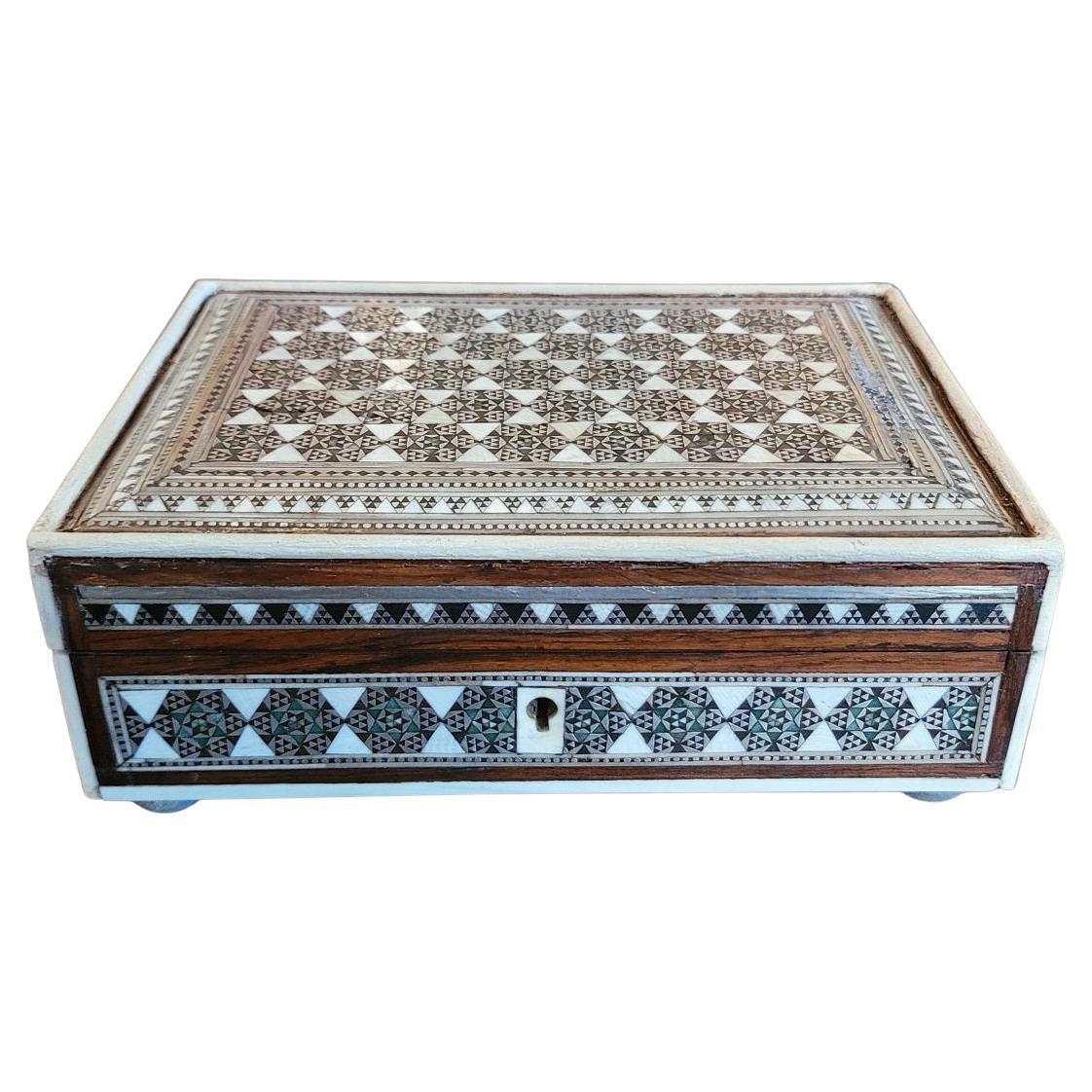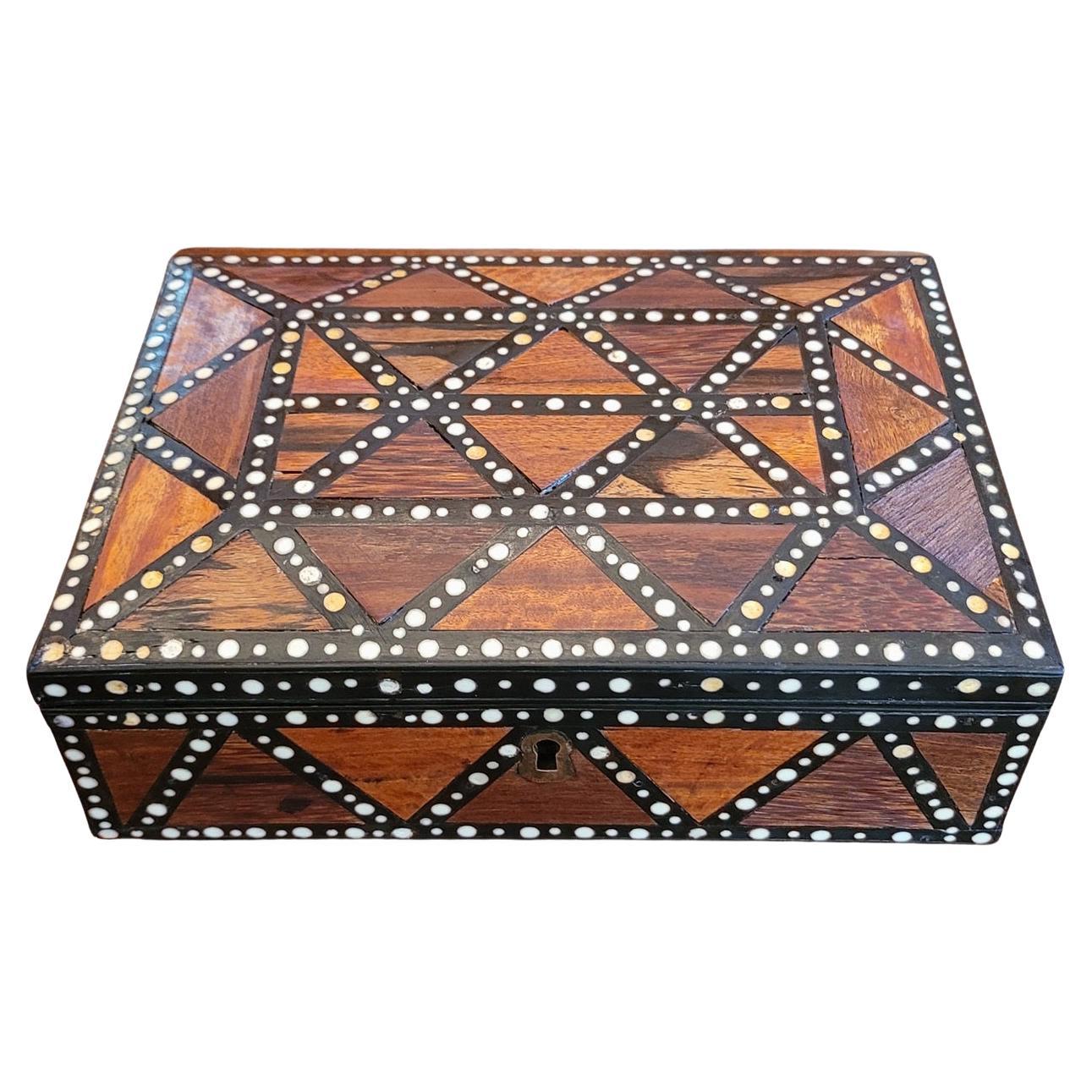Items Similar to Anglo Indian Faux Tortoise Trinket Box
Want more images or videos?
Request additional images or videos from the seller
1 of 7
Anglo Indian Faux Tortoise Trinket Box
About the Item
Inspired vintage Anglo Indian hinged box crafted in mahogany and clad in a faux tortoise laminate.
- Dimensions:Height: 2.5 in (6.35 cm)Width: 6 in (15.24 cm)Depth: 4 in (10.16 cm)
- Style:Anglo-Indian (In the Style Of)
- Materials and Techniques:
- Place of Origin:
- Period:
- Date of Manufacture:Circa 1960
- Condition:Wear consistent with age and use.
- Seller Location:Palm Beach, FL
- Reference Number:
About the Seller
4.9
Vetted Seller
These experienced sellers undergo a comprehensive evaluation by our team of in-house experts.
Established in 1992
1stDibs seller since 2009
1,008 sales on 1stDibs
Typical response time: 1 hour
- ShippingRetrieving quote...Ships From: Palm Beach, FL
- Return PolicyThis item cannot be returned.
More From This SellerView All
- Anglo Indian Tortoise and Bone BoxLocated in Palm Beach, FLImpressive Anglo Indian box crafted in mahogany and clad in tortoise shell decorated with bone straps, carved and painted floral panels, and paw feet. The inside has a mirror and bon...Category
Early 20th Century Indian Anglo-Indian Decorative Boxes
MaterialsBone, Tortoise Shell
- Antique Anglo Indian Bone and Tortoise BoxLocated in Palm Beach, FLImpressive antique Anglo Indian box crafted in mahogany, clad in tortoise shell, and ambitiously decorated with bone. The inside has a mirror and red felt lining.Category
Antique 19th Century Indian Anglo-Indian Decorative Boxes
MaterialsBone, Tortoise Shell
- Anglo Indian Metal Cat BoxLocated in Palm Beach, FLWhimsical silvered metal feline handcrafted with a folky charm that is hammered and etched in a decorated floral design that unexpectedly opens as a trinket box.Category
Early 20th Century Indian Anglo-Indian Animal Sculptures
MaterialsMetal
- Large Anglo Indian Elephant BoxLocated in Palm Beach, FLFolky silvered metal elephant handcrafted with a charming whimsical form hammered and etched designs that unexpectedly opens as a trinket box.Category
Early 20th Century Indian Anglo-Indian Decorative Boxes
MaterialsMetal
- Painted Decorated Anglo Indian Box with ElephantsLocated in Palm Beach, FLA very charming Anglo Indian painted decorated box with elephant, people, peacocks and mystical animal motifs, an outside bracket base and a brass...Category
Early 20th Century Indian Anglo-Indian Boxes
MaterialsHardwood
- Rosewood Anglo Indian TableLocated in Palm Beach, FLRosewood Anglo Indian table with a round top. The top is intricately carved with a border of several motifs, including a jungle complete with big ca...Category
20th Century Indian Anglo-Indian Side Tables
MaterialsRosewood
You May Also Like
- Anglo-Indian Silver Plate Metal / Trinket, Box Elephant, SculptureLocated in Los Angeles, CABeautiful silvered metal box of an elephant in a very traditional Anglo -Indian craft, art. Has an amazing age patina in contrast with the inside, as shown.Category
Early 20th Century Indian Anglo-Indian Decorative Boxes
MaterialsSilver Plate
- 19C Anglo Indian Bombay MOP Sadeli Mosaic Trinket BoxLocated in Dallas, TXPRESENTING a LOVELY 19C Anglo Indian Bombay MOP (Mother of Pearl) Sadeli Mosaic Trinket Box from circa 1875-85. Gorgeously detailed and hand-crafted ‘sadeli mosaic’ inlay, from the Bombay Area, with deep greens with silver, pewter, mother of pearl, bone and ebony in geometric patterns. The box case, is made of sandalwood but completely covered in MOP, bone, faux ivory, ebony and mosaic inlay. Edged with faux ivory and banded with a different pattern of sadeli mosaic. Some minor damage to the top (repair is obvious in pics) and ivorine replacements to some edging, but it still a BEAUTIFUL BOX and of real QUALITY! The mosaic work is FABULOUS! Box opens to reveal its original blue velvet lining. It sits on 4 (recently added) silvered button feet. SADELI MOSAIC: “Anglo Indian boxes were made in India for the English residents from the early part of the 18th century. They were brought back or sent back to England usually by the people who had commissioned them. From the beginning of the nineteenth century they were imported more commercially, although not in any significant numbers until the middle decades. They were very highly valued, especially the early ones, to the extent that the designs were copied on late 19th and early 20th century tins. The ancient art of Sadeli Mosaic is said to have been introduced from Shiraz in Persia via Sind to Bombay, a long time before the Anglo Indian boxes were made. It was a technique, which required a high degree of skill and patience. It was executed very lavishly, in that the frequent cuts wasted a great amount of the precious materials used. The workmanship was however more than commensurable to the value of the materials. Ivory, silver, pewter (or other metals), wood and horn were cut into faceted rods which were bound together to form geometric patterns. When the glue has set, the rods were sliced in transverse sections. This gave the maker a number of angled circular pieces in the original pattern. Several variations of patterns could be achieved by combining the materials in different ways. The ivory was sometimes dyed green to give an extra color. The mosaic pieces in a combination of patterns, often separated by ivory, ebony, horn or silver stringing were used to veneer sandalwood boxes. In the early boxes, which date from the turn of the 18th to the 19th century, there are large panels of mosaic covering tops and sides of boxes. It took incredible skill to cover such large areas without any shakes or wavering of the pattern. The corners and joins on these boxes are impeccably matched. The makers (reputed to be Persian) of Sadeli mosaic made in the first two decades of the 19th century displayed a total understanding of the qualities of the different materials they used. They combined substances, which can expand and contract according to atmospheric conditions with others, which are hard and unyielding. The result was a sharp definition of the lines and patterns, which made up the whole design. On the early boxes the designs look deceptively simple. The fact is, they emerged from a culture, which had mastered geometry and understood how to generate a pattern from a set number of points. The patterns are so harmoniously combined that their incredible complexity is not immediately apparent. The earliest Sadeli boxes...Category
Antique Late 19th Century Indian Anglo-Indian Jewelry Boxes
MaterialsSilver
- 19C Anglo Ceylonese Specimen Wood Trinket BoxLocated in Dallas, TXPRESENTING A BEAUTIFUL and RARE 19C Anglo Ceylonese Specimen Wood Trinket Box. Made in ‘Galle’, Ceylon (now Sri Lanka) circa 1860-80. Made for the ex...Category
Antique 19th Century Sri Lankan Anglo-Indian Jewelry Boxes
MaterialsBone, Hardwood, Ebony, Sandalwood
- Anglo-Indian Style Penwork BoxLocated in New York, NYIn the form of a house; the hinged top opening to an open interior. In the spirit of early nineteenth century pinworm on ivory boxes that were highly collected in Regency England.Category
20th Century English Anglo-Indian Decorative Boxes
MaterialsIvory, Wood
- 19C Anglo Indian Vizigapatam Stamp BoxLocated in Dallas, TXPresenting an absolutely gorgeous and very rare 19C Anglo Indian Vizigapatam stamp box. Made in Colonial India (the Time of the Raj) circa 1860. Prob...Category
Antique Mid-19th Century Indian Anglo-Indian Decorative Boxes
MaterialsBone, Shell
- Vintage Indian Cloisonné Round Brass Trinket BoxLocated in Chicago, ILVintage cloisonné round trinket box, with black and gold flower and foliage decorating the lid. Made in India sticker on bottom.Category
20th Century Indian Anglo-Indian Decorative Boxes
MaterialsMetal, Brass
Recently Viewed
View AllMore Ways To Browse
Indian Box
Bird Box Bruguier
Soap Dish With Cover
Jay Strongwater Box
King Queen Set Gold With Blue Velvet
Sovereign Proof
Antique Wood And Brass Boxes
Chinoiserie Box Black And Gold
Indian Sandalwood
Antique Mother Of Pearl Inlay Box
Wooden Tool Boxes
Nicole Freres
Morici Watch Box
Dog Pill Box
Elephant Money Box
French Cut Crystal Perfume Box
Georgian Patch Box
German Silver Compact Mirror





